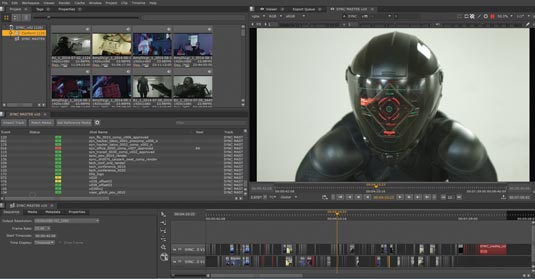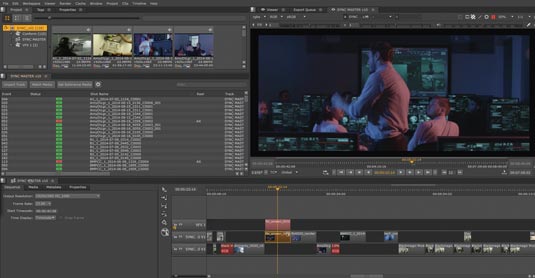The Foundry makes Nuke available for free
The Foundry has launched a free non-commercial version of Nuke. Find out what it can do.

Following Renderman, Unreal Engine and others, The Foundry has launched a free non-commercial version of Nuke.
This means that students and indie-filmmakers who haven't yet got funding for their project can go ahead and use Nuke for free – you only pay once the project becomes a commercial one.
"We're offering free, non-watermarked versions of NUKE, NUKEX and even top-of-the-line NUKE STUDIO to anyone who wants to learn, explore and have fun," says the company. "If you want to learn to composite, edit and finish with industry-leading tools, NUKE Non-commercial is for you. You can work on personal projects, update your skills, experiment, research or just play around."
Want to learn more about the latest version of Nuke Studio? Here's the in-depth review leading indie director Hasraf Dulull wrote for the issue 191 of 3D World magazine...
All-in-one solution

When I first saw the announcement of Nuke Studio from The Foundry I was very excited, especially as I have been using Nuke since it was first released. The idea of having an all-in-one editorial and compositing environment has long been a popular request from studios of all sizes, and individual users.
In order to review this software fully I used my recently released short film project Sync and conformed its entire timeline into Nuke Studio. When I launched the software, it felt very familiar to The Foundry's conform, shot-management and review tool, Hiero.
So the first thing I did in Nuke Studio was to bring in my EDLs of the video layers from Adobe Premiere (Sync was edited in this). The interface all looks familiar and it's very easy to figure out what does what without reading the manual – meaning I could hit the ground running.
Daily design news, reviews, how-tos and more, as picked by the editors.
World of joy
One of the first things I did was to go into the Conform area of Nuke Studio, select all my clips and choose the Match Media function to point them to the source media. (As with all conforms, it's all down to how big your project is in terms of media.)
But when compared to the likes of Final Cut Pro (FCP) and Premiere's reconnect media feature, Nuke Studio isn't smart enough when doing its conform to give you the option to skip files, and it has problems bringing in or providing a list of files it couldn't bring in after successfully importing the others (again Premiere and FCP do this well).

You may ask why I would want to conform the whole film, and I hear you, but with independent feature films where the filmmaker is very hands on with the edit and VFX, a workflow which allows editorial VFX to be done in an online editorial fashion is extremely important.
Once I was able to get the conform working, I entered a world of joy! Nuke Studio enabled me to edit and do compositing at the same time, all in one environment. It has been designed to give you a full suite of tools for composting, shot management, conform, review and finishing for VFX productions, enabling very collaborative workflows. It's almost as if Nuke Studio is the love child of both Hiero and Nuke.
Getting right inside
With Nuke Studio you'll never need to render out your source material for compositing, like you would usually do. Instead you
can scrub though the editorial timeline to find a clip and then select Create Comp.
Doing this instantly takes you to an option where you want the comp to be saved and then you're right inside a Nuke comp, all set up automatically with the meta data, frame range and write node. All this without ever leaving the editorial environment or even setting a comp script up.
You can carry out your comp just as you would in the standalone Nuke. There aren't many updates on the comp tools themselves, but they all work really well. The inclusion of the Denoise node is an especially useful one, I found, as it enables you to create cleaner images with fewer artefacts.
Timeline
You can also render out directly into the timeline in a new layer on top of the original clip, enabling you to flip between the two when comparing. This tool is very useful for VFX review dailies.
This converged environment is made possible as Nuke Studio features several new workspaces: Compositing, Conforming, Editing, Finishing and Reviewing.
Nuke Studio's timeline also allows you to easily apply LUTs on a clip-by-clip basis, and this means that using source material shot with different cameras is not a nightmare when editing and doing comps.

I also found the Tagging feature (popular in Hiero) to be very useful. For example, I could tag several greenscreen plates that I liked and mark those specific ones as elements to use to combine together to make the final shot.
Real-time 4K playback
Nuke Studio reminds me of Autodesk's Flame and the main reason why clients love coming to Flame facilities when doing commercials is that they can see VFX in the context of a timeline
as opposed to single shots.
If you set up Nuke Studio on a fast machine with SSDs or a good RAID system, it could easily become the desktop alternative to Flame for studios or even individual VFX artists with commercials or fast turnaround projects. The software would enable clients to be more involved with the VFX across the film when doing reviews and on the spot changes to shots.
However, for its current price point, Nuke Studio is still a very big investment, especially for the average VFX artist. And for those who already have licenses of Hiero and Nuke it's probably not really worth the change, for now.
Words: Hasraf Dulull
Hasraf 'HaZ' Dulull is a freelance VFX supervisor who recently transitioned into filmmaking, with his short films being optioned into feature film development with Hollywood studios. You can watch his films here.

The Creative Bloq team is made up of a group of art and design enthusiasts, and has changed and evolved since Creative Bloq began back in 2012. The current website team consists of eight full-time members of staff: Editor Georgia Coggan, Deputy Editor Rosie Hilder, Ecommerce Editor Beren Neale, Senior News Editor Daniel Piper, Editor, Digital Art and 3D Ian Dean, Tech Reviews Editor Erlingur Einarsson, Ecommerce Writer Beth Nicholls and Staff Writer Natalie Fear, as well as a roster of freelancers from around the world. The ImagineFX magazine team also pitch in, ensuring that content from leading digital art publication ImagineFX is represented on Creative Bloq.
